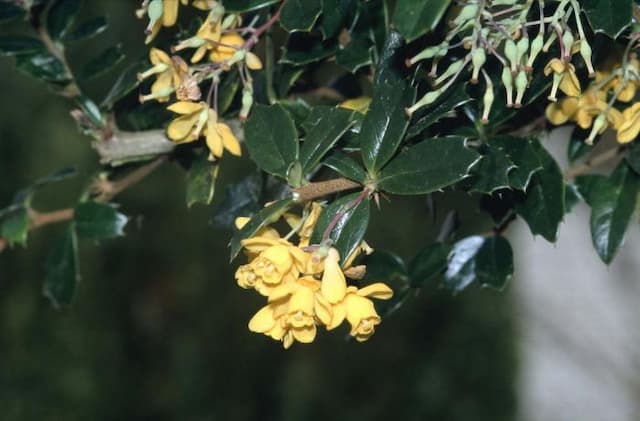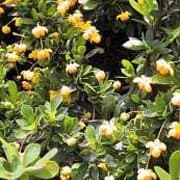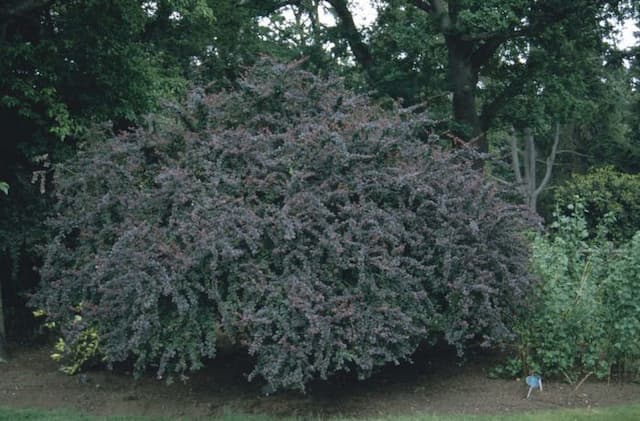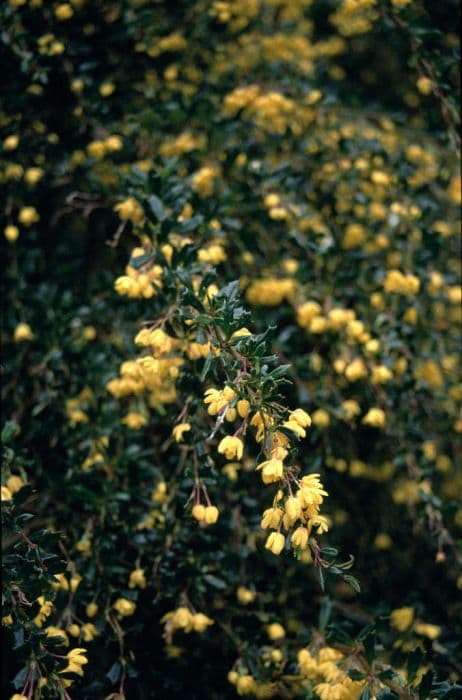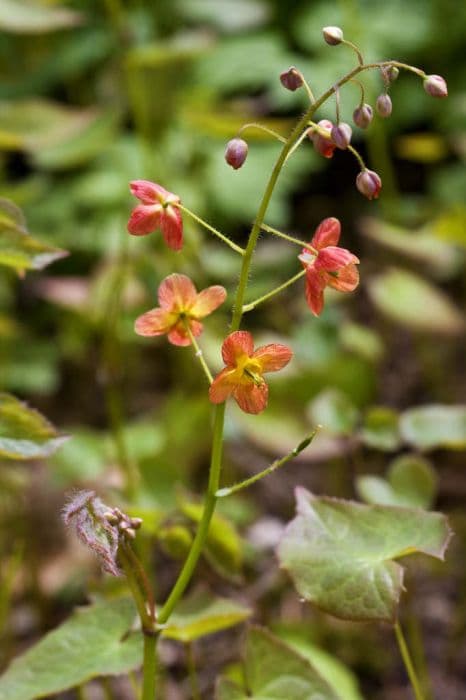Barrenwort Epimedium × perralchicum 'Lichtenberg'

ABOUT
The plant known as Epimedium × perralchicum 'Lichtenberg', or more commonly referred to as Barrenwort, showcases a unique and attractive appearance. It's characterized by its striking foliage that emerges in spring with a mix of bronzy-pink shades. As the leaves age, they transform into a lush green color, providing a lovely backdrop for the flowers. Barrenwort blooms are particularly charming; they dangle in clusters from slender stems and resemble tiny fairy wings. The flowers themselves exhibit an enchanting combination of colors, typically featuring a light yellow hue at the center with outer petals that can range from a soft lilac to a deeper purple. The contrast between the delicate flowers and the robust leaves is a prominent feature of this plant. Another enchanting aspect of Barrenwort's appearance is the shape of its leaves, which are often heart or spade-shaped and possess a soft, leathery texture. This fine texture is accented by a delicate edge, giving a ruffled or serrated look to the foliage. The combination of its delightful flowers and attractive foliage makes Barrenwort a popular choice for gardeners seeking to add a touch of whimsy and color to their garden tapestry.
About this plant
 Names
NamesFamily
Berberidaceae.
Synonyms
Barrenwort, Bishop's Hat, Fairy Wings, Horny Goat Weed.
Common names
Epimedium × perralchicum 'Frohnleiten'.
 Toxicity
ToxicityTo humans
The plant Epimedium × perralchicum 'Lichtenberg', commonly known as Bishop's Hat, is not known to be toxic to humans. There are no well-documented cases of poisoning from the ingestion of this plant, so it is generally considered safe around people in terms of toxicity. Still, it is recommended that no part of the plant be ingested as a precaution and to avoid potential allergic reactions or unforeseen consequences.
To pets
The plant Epimedium × perralchicum 'Lichtenberg', commonly known as Bishop's Hat, is also not known to be toxic to pets. There is no significant evidence to suggest that Bishop's Hat poses a risk of poisoning to animals such as dogs and cats if they ingest it. As with any non-food plant, consumption is generally not encouraged due to the potential risk of gastrointestinal upset or an unpredictable allergic reaction, but there are no specific toxic effects associated with this species for pets.
 Characteristics
CharacteristicsLife cycle
Perennials
Foliage type
Evergreen
Color of leaves
Varies
Flower color
Yellow
Height
1-2 feet (30-60 cm)
Spread
1-2 feet (30-60 cm)
Plant type
Herb
Hardiness zones
5
Native area
Asia
Benefits
 General Benefits
General Benefits- Attracts Pollinators: The plant's flowers can attract bees and other beneficial insects, aiding in the pollination of surrounding plants.
- Ground Cover: It can serve as an effective ground cover, reducing weed growth and soil erosion.
- Drought Tolerance: Once established, the plant has a degree of drought tolerance, requiring less frequent watering.
- Shade Tolerant: It performs well in partial shade, making it suitable for planting under trees or in shadowy garden spots.
- Deer Resistance: The plant is known to be relatively resistant to browsing by deer, which can be beneficial in areas where deer predation is a problem.
- Aesthetic Appeal: With its attractive foliage and flowers, it adds aesthetic value to gardens and landscaped areas.
- Low Maintenance: It generally requires minimal care once established, making it a convenient choice for gardeners of all skill levels.
- Seasonal Interest: It provides visual interest across multiple seasons with foliage that may change color in the fall and blooms in the spring.
 Medical Properties
Medical PropertiesThis plant is not used for medical purposes.
 Air-purifying Qualities
Air-purifying QualitiesThis plant is not specifically known for air purifying qualities.
 Other Uses
Other Uses- Erosion Control: Epimedium plants, also known as Bishop's hat, are effective at stabilizing soil on slopes and preventing erosion due to their dense root systems.
- Livestock Forage: In some areas where traditional forage is scarce, Bishop's hat may be used as a supplemental food source for grazing animals, although this is not common.
- Natural Dye: The leaves and stems of the Bishop's hat plant can be used to produce a natural dye for textiles, although this is not a widely practiced use.
- Ground Cover: Due to its dense foliage, Bishop's hat can be planted in garden areas where a low-maintenance ground cover is desired to suppress weeds.
- Fairy Gardens: Miniature and whimsical, Bishop's hat can be used in creating fairy gardens where its small, delicate flowers add a touch of magic.
- Seasonal Decoration: The attractive foliage of Bishop's hat, which often changes color in the fall, can be used in autumn floral arrangements and decorations.
- Leaf Litter: Falling leaves from the Epimedium can be left to decompose and enrich the soil as a natural mulch and fertilizer.
- Bonnets and Costume Design: The interesting leaf shape of Bishop's hat has been an inspiration for creative bonnets and costume design in historical period pieces and theater.
- Photography Backdrops: The lush foliage and delicate flowers of Bishop's hat provide a beautiful, natural backdrop for outdoor photography.
- Mosaic Inspirations: The heart-shaped leaves of Bishop's hat can inspire designs for garden mosaics or stepping stones.
Interesting Facts
 Feng Shui
Feng ShuiThe plant commonly known as Barrenwort is not used in Feng Shui practice.
 Zodiac Sign Compitability
Zodiac Sign CompitabilityBarrenwort is not used in astrology practice.
 Plant Symbolism
Plant Symbolism- Sensual Pleasure: Often referred to by its common name, "Barrenwort," Epimedium has a reputation for being an aphrodisiac, symbolizing sensuality and eroticism. This is likely due to the plant's history in traditional medicine, where it has been used to enhance sexual function and desire.
- Resilience: Barrenwort is known for its ability to thrive in tough conditions, often growing well in dry shade where other plants might struggle. It symbolizes the ability to endure and prosper despite challenging circumstances.
- Protection: As ground-covering perennials, these plants form a protective layer over the soil, symbolizing shelter and safety. Their robust nature provides a sort of guardianship for the more delicate biodiversity of the garden.
- Youthful Vitality: The plant is also touted for its alleged anti-aging properties, symbolizing youthfulness and vitality.
 Water
WaterThe Barrenwort should be watered regularly, providing an inch of water each week. During the first growing season, it's important to maintain a consistent watering schedule to establish a deep, extensive root system. Once established, Barrenwort is quite drought-tolerant and will usually require less frequent watering. However, if you're experiencing an extended period without rainfall, additional watering may be necessary. Be cautious not to overwater the plant, as Barrenwort does not like to sit in wet soil.
 Light
LightBarrenwort thrives best in partial to full shade. The ideal spot for the plant is beneath the canopy of a deciduous tree where it can receive filtered sunlight or in a shady area where direct sunlight doesn't reach. Avoiding intense afternoon sun will help to prevent the leaves from scorching.
 Temperature
TemperatureBarrenwort is hardy and can withstand a wide range of temperatures, surviving minimum winter temperatures down to -20 degrees Fahrenheit. The ideal temperature range for this plant is between 50 and 70 degrees Fahrenheit. It can tolerate the summer heat as long as it is not in direct sun and has sufficient moisture.
 Pruning
PruningBarrenwort doesn't require frequent pruning, but it is beneficial to remove any dead or damaged foliage in early spring to make room for new growth. The best time for pruning is after the blooming period has ended, usually by cutting back the flower stems. Regular pruning is not necessary; just clean up as needed to maintain the plant's appearance.
 Cleaning
CleaningAs needed
 Soil
SoilBarrenwort prefers well-drained soil rich in organic matter with a pH between 6.0 and 7.5. A mixture of leaf mold, compost, and loamy soil suits it best for nutrients and drainage.
 Repotting
RepottingBarrenwort doesn't require frequent repotting; it can be repotted every 3 to 4 years or when it's clearly outgrown its current container.
 Humidity & Misting
Humidity & MistingBarrenwort thrives in average to high humidity levels, mimicking its natural woodland habitat; however, it is quite adaptable and does not have specific humidity requirements.
 Suitable locations
Suitable locationsIndoor
Provide dappled shade, cooler temperatures, and avoid dry air indoors.
Outdoor
Part shade to full shade, protect from intense midday sun.
Hardiness zone
5-9 USDA
 Life cycle
Life cycleThe Epimedium × perralchicum 'Frohnleiten', commonly known as the Barrenwort or Bishop's Hat, begins its life cycle when its rhizomes (underground stems) send up shoots in early spring. Leaves emerge, which are heart-shaped with a red-tinted, leathery texture, often with a bronze hue that turns green as they mature. Simultaneously, clusters of small, yellow flowers with distinctive spurs develop above the foliage on wiry stems, blooming from mid to late spring. As the blooming period ends, the plant continues to grow and spread, forming a dense ground cover with its foliage. In the autumn, the leaves may turn reddish-brown, adding seasonal interest before they die back in the winter. The rhizomes survive the cold season to send up new growth when the temperatures rise again, repeating the annual cycle.
 Propogation
PropogationPropogation time
Spring-early summer
The Epimedium × perralchicum 'Frohnleiten', commonly known as barrenwort or bishop's hat, can be propagated most effectively by division, which is best performed in the spring or fall. To propagate by division, carefully lift the parent plant from the soil, preferably after it has finished flowering, and gently separate the rhizomes, making sure that each division has at least one growth bud. Replant the divisions at the same depth they were previously growing, spacing them about 12 inches (approximately 30 centimeters) apart to allow enough room for growth. Water the new plants thoroughly to help establish them. This method encourages quick establishment and minimizes stress on the plants, allowing them to thrive and spread in their new location.
